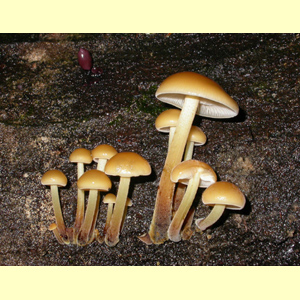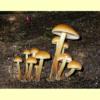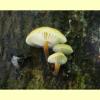
images/Flammulina_velutipes/Flammulina_velutipes2.jpg
Small to medium (occasionally large) agaric, growing in caespitose clusters on wood (sometimes buried), and with white to pale cream spore print. Pileus pale, yellow, orange or brown, viscid or glutinous. Lamellae free, adnexed, adnate, sinuate or notched or subdecurrent. Stipe central or excentric, pale above, dark below, velvety. Partial veil remnants absent. Spores hyaline, non-amyloid, smooth; germ pore absent. Cheilocystidia and pleurocystidia present. Lamellar trama regular or weakly bilateral. Pileipellis a trichoderm or a hymeniderm; pileocystidia present. Clamp connections present.
The combination of viscid pileus with yellow or orange tones and a velvety stipe is unique among white-spored agarics with a central stipe that grow on wood.
Xeromphalina and
Heimiomyces can have similar colours, but they have a dry pileus and amyloid spores. Some
Mycena species grow in clusters on wood and have viscid or glutinous pileus, but these are generally grey or brown, and have amyloid spores.
Mycena leaiana grows in clusters on wood and has a viscid pileus that can be orange, but the stipe is squamulose rather than velvety, the lamellae are orange and usually have a darker edge, and the spores are amyloid. Caespitose species of
Hypholoma can have similar pileus colour, but the spore print is purple-brown.
Flammulina P.Karst., Meddeland. Soc. Fauna Fl. Fenn. 18: 62 (1891).
One species: recorded as Flammulina velutipes. The correct name for Australian material needs investigation. Bas (1983) described wide variation in F. velutipes from Europe. There is an endemic taxon in New Zealand, Flammulina stratosa on Nothofagus (Redhead et al. 1998).
Flammulina velutipes (Curtis) Singer, Lilloa 22: 307 (1951).
W.A., S.A., Qld, N.S.W., Vic. and Tas. (and probably also N.T.).
In native forests, including cool-temperate rainforest (with Nothofagus), and also in parks or gardens, on exotic trees such as Celtis and Ulmus. Native hosts include Acacia and Atherosperma.
On wood, mostly stumps or logs but sometimes standing living trees (from wounds or dead limb stubs).
Saprotrophic.
Bas, C. (1983),
Flammulina in western Europe,
Persoonia 12: 51–66. [
Description and
Microcharacters of
F. velutipes]
Breitenbach, J. & Kränzlin, F. (eds) (1991), Fungi of Switzerland. Volume 3. Boletes and Agarics 1st part. Edition Mykologia, Lucerne. [Illustration, Description and Microcharacters of F. velutipes from Europe]
Fuhrer, B. (2005), A Field Guide to Australian Fungi. Bloomings Books, Hawthorn. [Description and Illustration of F. velutipes]
Fuhrer, B. & Robinson, R. (1992), Rainforest Fungi of Tasmania and South-east Australia. CSIRO Press, East Melbourne. [Illustration of F. velutipes]
Grgurinovic, C.A. (1997a), Larger Fungi of South Australia. The Botanic Gardens of Adelaide and State Herbarium and The Flora and Fauna of South Australia Handbooks Committee, Adelaide. [Description and Microcharacters of F. velutipes]
McCann, I.R. (2003), Australian Fungi Illustrated. Macdown Productions, Vermont. [Illustration of F. velutipes]
Redhead, S.A., Petersen, R.H. & Methven, A.S. (1998), Flammulina (Agaricales): F. stratosa, a new New Zealand species distantly related to the cultivated Enoki mushroom, Canad. J. Bot. 76: 1589–1595. [Description, B&W Illustration and Microcharacters of F.stratosa]
Shepherd, C.J. & Totterdell, C.J. (1988), Mushrooms and Toadstools of Australia. Inkata Press, Melbourne. [B&W Illustration of F. velutipes (as 'veluticeps')]
Young, T. (2000a), Common Australian Fungi, [3rd] revised edn. University of New South Wales Press, Sydney. [Description, B&W Illustration and Microcharacters of F. velutipes]





